
This month we look at the best in fantasy games. This is without a doubt my favorite genre; a logical progression of my affinity for the classic dungeon and dragon games. And as we saw with war-game simulations, we again find that the computerized fantasy games open the D & D genre to a much larger audience, with a mighty microprocessor replacing complex result tables and multisided dice. In the category of fantasy games, there are three lines of evolution which are the best.
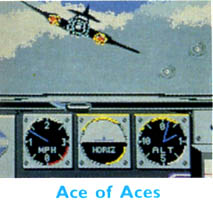 The first, and what I consider the best line to follow, is the
Phantasie series from SSI.
This trilogy follows a brave band of
adventurers through their trials and tribulations as they tackle the
evil dark lord Nickademus. These games were the first fantasy games to
tap the vast graphic power and menuing capabilities of the ST The 8-bit
versions, while lacking the sensational graphics, still exhibit the
engaging story lines and puzzles that boost Phantasie above all the
competition. The only drawback is a lengthy and needlessly involved
setup procedure. Unfortunately for 8-bit owners, as of this writing,
only the first two installments are available for our machines.
The first, and what I consider the best line to follow, is the
Phantasie series from SSI.
This trilogy follows a brave band of
adventurers through their trials and tribulations as they tackle the
evil dark lord Nickademus. These games were the first fantasy games to
tap the vast graphic power and menuing capabilities of the ST The 8-bit
versions, while lacking the sensational graphics, still exhibit the
engaging story lines and puzzles that boost Phantasie above all the
competition. The only drawback is a lengthy and needlessly involved
setup procedure. Unfortunately for 8-bit owners, as of this writing,
only the first two installments are available for our machines.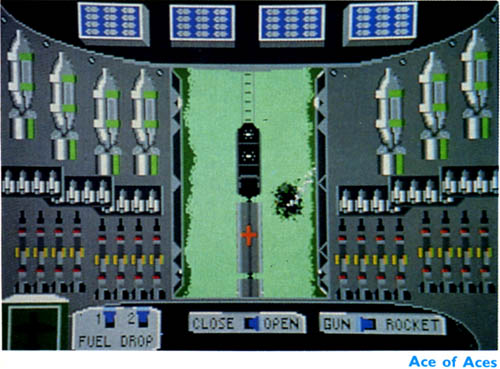
Using your arsenal of
explosives,
sleeping gas, fake I.D. papers and
a camera and mine detector, you
infiltrate the enemy compound.
sleeping gas, fake I.D. papers and
a camera and mine detector, you
infiltrate the enemy compound.
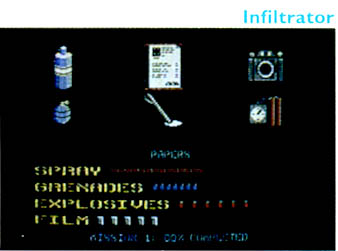
For those who want a little more difficulty, Datasoft offers up Alternate Reality. The premise is abduction based-you've suddenly been transported away from your comfortable home and into an alternate reality, a medieval world full of adventure and danger. So far there are two such worlds, The City and The Dungeon. Both play pretty much alike, allowing simple interaction between you and each world's many inhabitants. The main drawback of the game and a contributing factor to its difficulty, is the fact that you cannot save your position before attempting to survive a dangerous situation. Saving a game does just that-saves the game and terminates the program. The save-game disk is then used to restart. This operational aberration calls for an altogether different play strategy.
Beginners may find refuge in the Wizard's Crown series. These simple games are the perfect introduction to computerbased D & D for experienced gamers, due to their moderate level of difficulty. The goal is to search for the wizard's crown, using eight characters which you design. Wizard's Crown and its sequel, The Eternal Dagger require 50 hours of play to complete, and it is 50 hours well spent indeed, with the only drawbacks being an overly complex and poorly designed setup procedure and difficult-to-use command structure.
Unfortunately I have no new fantasies to share with you this month. I hope that Phantasie III is soon converted to 8-bit, but until that time we'll just have to make do with one of these.
Infiltrator
Mindscape
3444 Dundee Road
Northbrook, IL 60062
64K disk, $29.9S
Ace of Aces
Accolade
20813 Stevens Creek Blvd.
Cupertino, CA 95014
64K disk, $29.95
This month we have not one, but two-count them-two flight simulators. Yes, into a market saturated with similar games, Accolade and Mindscape have chosen to launch their own air-based battle and strategy games. And while I tired long ago of flight simulators, I'll try to hang onto my sanity just long enough to tell you if they're air worthy.
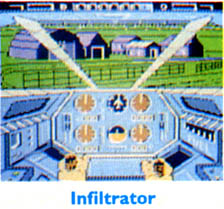 In Mindscape's new game, Infiltrator,
you are
Captain Johnny "Jimbo Baby" McGibbits, the Infiltrator. Your mission,
should you choose to accept it, is to complete three separate
assignments, each comprised of a flight into enemy territory, a ground
mission and the flight out. As an Infiltrator, success will hinge on
your ability to remain hidden from the enemy, sneaking in and out of
hostile territory, fighting only when forced to. Your craft is the
Gizmo DHX-I Attack Chopper, nicknamed "The Snuffmaster" and before you
hit the skies you'll have to take a little time out to learn at least
some of this aircaft's incredible and diverse capabilities.
In Mindscape's new game, Infiltrator,
you are
Captain Johnny "Jimbo Baby" McGibbits, the Infiltrator. Your mission,
should you choose to accept it, is to complete three separate
assignments, each comprised of a flight into enemy territory, a ground
mission and the flight out. As an Infiltrator, success will hinge on
your ability to remain hidden from the enemy, sneaking in and out of
hostile territory, fighting only when forced to. Your craft is the
Gizmo DHX-I Attack Chopper, nicknamed "The Snuffmaster" and before you
hit the skies you'll have to take a little time out to learn at least
some of this aircaft's incredible and diverse capabilities.The features found in this chopper read like Rambo's Christmas wish list: air-to-air heat-seeking missiles, a pair of rapid-fire 20mm cannons, a turbo booster to get you out of tight situations, flares and chaff to decoy enemy fire and sophisticated communications, guidance, control and surveillance systems. In the spirit of a true simulation, nearly every system is present and accounted for, and you are required to step through as many procedures to get this chopper off the ground as you would find yourself doing with the real thing.
Start by turning on the battery and initializing the computer system. Pressing I starts your engine. Use the joystick to control movement, while the keyboard arms your various offensive and defensive weapons systems. Pressing the fire button launches your attacks. And if this sounds complicated, wait until you see the cockpit. Once you learn what every dial, read out and warning light in the ultrasophisticated cockpit is trying to tell you, you'll never be in the dark again. In addition to the expected compass, artificial horizon and altimeter and airspeed indicator, warning lights and gauges keep you apprised of critical fuel levels, engine and battery temperatures and engine damage. Sensors detect incoming missiles, while your computer terminal displays craft status and a tactical map. A communications facility allows limited contact with other aircraft, a correct response to messages being required to avoid an attack. And you'll want to avoid a lot of battles if you hope to reach your destination.
Upon arrival, you exit your cockpit and proceed on foot. Using your arsenal of explosives, sleeping gas, fake ID papers and a camera and mine detector, you infiltrate the enemy compound, searching rooms, photographing secret documents. You will be informed when you have completed the mission, so you can hightail it back to your chopper, having saved the world yet again.
As if this were not excitement enough for a worldclass hero, we have yet another flight simulator this month. Into the oversaturated market Accolade launches Ace of Aces, a combat flight simulator patterned after the Mosquito, a maverick RAF fighter bomber of World War II. On your way to becoming "Ace of Aces," you work your way through four missions, involving air battles, train bombings, sub sinkings and the eradication of V I rockets before they reach mother England. In each mission, the threat of aerial dogfights with Nazi fighters is always present.
After booting up this game, you might want to start in practice mode to familiarize yourself with the controls. The opening sequence (a series of photographs depicting an aircraft scramble as an air-raid siren blares annoyingly in the background) is best skipped by pressing the joystick button. Lacking the complexity of Infiltrator, your cockpit in Ace contains only the bare essentials-not unexpected, as this is a primitive WWII aircraft. The pilot's view contains dials indicating airspeed and altitude, while the engineer's view allows you set the throttle and flaps and monitor fuel and engine speed.
On your way to
becoming "Ace of
Aces;" you work your way
through air battles, train
bombings, sub sinkings and
the eradication of V1 rockets.
Aces;" you work your way
through air battles, train
bombings, sub sinkings and
the eradication of V1 rockets.
The navigator's map shows your position relative to enemy installations, and using the bombardier's view you drop bombs and inventory your armaments. You move through these views by pressing a keyboard number or clicking the joystick button twice and manipulating the stick. An on-screen figure of your plane reminds you which stick direction activates each view, and the figure doubles as a trouble indicator. For example, the rear of the plane lights up when the tailbased navigator should be consulted. Once you gather up enough courage to chance a real mission, you'll be presented with a menu allowing you to designate what types of targets you'll pursue. Next, load your plane with the correct mix of weapons and fuel.
The manual reminds you that bombs are a must for trains and subs, while lots of fuel will be needed for long missions and engaging enemy fighters in dogfights. And once the enemy is vanquished, the mission is over. Unlike Infiltrator, Ace never requires you to leave the cockpit. The complexity in each of these games makes control hard to learn. I found Ace to be more intuitive, thus a little easier to get a grip on. On the other hand, while Infiltrator was a little harder to play, it was also more challenging. However, I did feel that Infiltrator went a little too far in trying to make you feel you were in the pilot's seat. For instance, there's a lot of foolishness as you start each game; the program requiring you to get a number from one console and input it into another to set your guidance system. One would hope a craft as sophisticated as the Snuffmaster would have peripherals that can communicate with one another. The controls on Ace seemed a little more responsive, although both aircrafts were sluggish, lacking the instant response of arcade and ST-based simulators. To make things worse, Ace occasionally accessed the drive before displaying a new screen. Graphics again were very similar, although I'd have to award this skirmish to Infiltrator. Its cockpit was just a little more detailed. And while both featured a vast number (for 8-bit games) of gauges and indicators, all highly detailed, enemy planes were crudely drawn, explosions less than spectacular. To round out the graphics area, a special mention for Ace is in order for its creative views looking out over each wing.
The manual for Infiltrator is thick and quite complete. It sets up the scenario of the game, then goes on to describe the control and design of the Gizmo DHX-I in great detail. Numerous illustrations help you quickly identify the various systems in the cockpit and the entire manual is written in a lighthearted way. While I found that the constant "cuteness" of the prose became annoying, it was, at least, not boring. A handy reference card is also included. The documentation for Ace of Aces is much less elaborate (and less cute) than Infiltrator's. However, it does contain most of what you'll need to know about the game along with ample diagrams, so you won't be wondering what the various displays will look like. Unfortunately for 800 owners, both games require 64K and will not settle for anything less.
It's kind of hard to pick a winner here; I feel like a voter-powerless and forced to choose the lesser of two evils. In this case, that would have to be Ace of Aces. It was easier to learn and offered most of what Infiltrator did, save the ground mission, which I could have done without anyway. But either of these games will let the prospective pilot take to the skies.

Plundered Hearts
Infocom
125 Cambridge Park Drive
Cambridge, MA 02140
48K disk, $34.95
With the release of their latest work of interactive fiction, Infocom has produced the first such story written by a woman, as well as made its entry into the genre of romance. Spearheading this two-fisted attempt to attract more female purchasers, Amy Briggs has crafted a pirate story full of intrigue, adventure and, yes, romance. Unfortunately, I think most of Infocom's regular audience (presumably male) are likely to forsake this bold new endeavor.
In Plundered Hearts, you are a beautiful young woman who has just received a message detailing how a grave illness has befallen your father. He now lies near death on a tropical island, and an unknown friend, Jean Lafond, claiming to the governor of the island, has penned the note, because your father is too weak to even lift a hand. He pleads that your encouragement may be his only hope. Being a loyal, loving daughter, you board one of the governor's ships and set sail.
Spearheading this
two-fisted
attempt to attract more female
purchasers, Amy Briggs has crafted
a pirate story full of Intrigue,
adventure and, yes, romance.
attempt to attract more female
purchasers, Amy Briggs has crafted
a pirate story full of Intrigue,
adventure and, yes, romance.
But two days into the voyage, pirates attack. The captain of your ship, Bartholomew Davis, who might be considered less than heroic, immediately sees in you a way to divert the pirates, saving his own skin. You are locked in his cabin. Moments later, the door breaks in, and a vile piece of humanity grasps you in his arms. He clutches you tightly, fouling your face with a breath reeking of rum. Just moments before he has his way with you, he slumps, having been knocked unconscious by his leader, one Captain Nicholas Jamison, also known as the Falcon. He too has a note from your father, labeling Lafond a traitor, and telling you to trust and accompany the Falcon. Does the fact that you feel so attracted to this fine specimen of a man make it a little too easy to trust him? But then, what choice do you have, as your ship burns, the cowardly Davis lying slain at your feet? You go with the Falcon and begin a journey unlike any you've ever imagined.
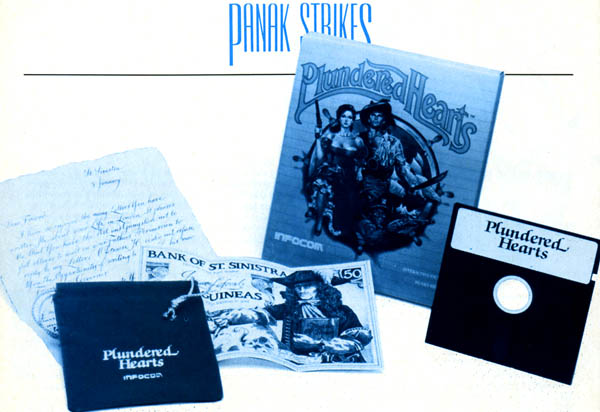
Since this game is targeted, presumably, at first-time Infocom customers, I'll take a minute to cover some program specifics. (Regular users will want to jump to the next paragraph.) In interactive fiction, you control the game by issuing commands to the main character in a story. In theory, as in a good book, you project yourself into this character. What distinguishes Infocom stories is the complexity of the program's parser and the power of its prose. The program understands (and occasionally demands) complete sentences, containing subject, verb, direct object and adjectives. Abbreviations speed you through often-used commands, while special commands allow you to save your place in the novel, control verbosity and print a journal.
And the simplicity with which you communicate with the program allows you to fully enjoy the rich descriptions and action. Just relax and let the story unfold.
Getting back to Plundered Hearts, included in every package is a velvet reticule (a pouch) containing a 50 guinea note and a letter from Jean Lafond. Also included is the standard Infocom instruction manual, explaining how to play the game, giving helpful tips and highlighting common problems. Finally, a special coupon will allow purchasers to enjoy Cutthroats, another Infocom pirate story, at a special price. But still, I have a lot of trouble recommending this game to everyone.
This is because romance is my least favorite literary form. My personal tastes, firmly ingrained by a childhood filled with Twilight Zone, Star Trek and bad B movies, run toward horror, fantasy and science fiction. So, it should not come as a surprise that I didn't care much for the story. Newcomers will find the puzzles to be standard Infocom fare, and advanced players will find it relatively easy.
Plundered Hearts should be looked at as just what it is, a romantic work of fiction. One trip to the bookstore will convince you that romance is a viable, popular and profitable literary genre. And with the game's program design and prose up to Infocom's traditional high standards, romance readers might just find it worth their while to turn on to these pages.
That's a wrap for this month. But before I go, some old business. I took a look at Bridge 5.0 last month, and in the interim a new version has been released. A cursory test has revealed that although the last version's weak bidding has been strengthened, the auto-play mode still needs some work. Whether you want to hold out for yet a better version is dependent on how much you want to play bridge. Next month: the latest simulation from SSI and yet another flight simulator. Until then, good gaming.
In the six years since Steve joined the Atari community, he has spent thousands of hours playing hundreds of games. Between games, he is an attorney and trust officer in a large Ohio bank. Steve is still searching for the perfect game.